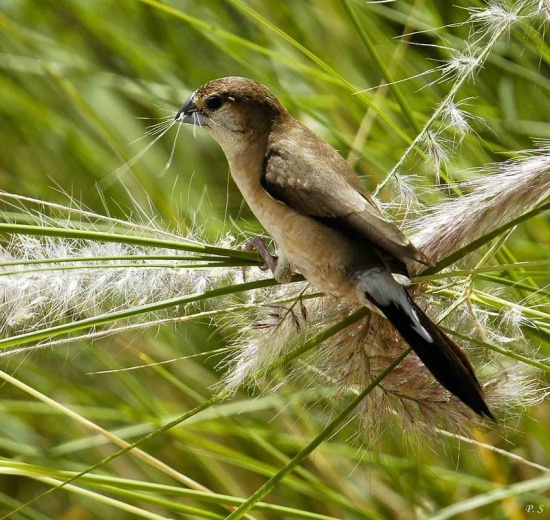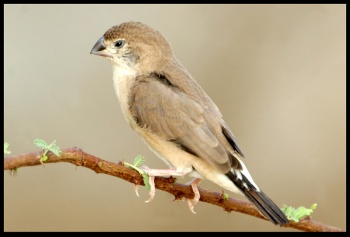Alternative names: White-throated Munia, White-throated Silverbill or Warbling Silverbill as well as Euodice malabarica
- Euodice malabarica
Lonchura malabarica
Identification
11 cm long
Creamy underside with darker upperside, often displaying dark to black primaries along the lower edge of the folded wing, as well as a dark tail that is often somewhat pointed. White rump is sometimes visible on the sitting bird, and always visible in flight. Bill has a dark, curved, upper mandible while the lower mandible is lighter often reflecting.
This species is very similar to African Silverbill (Lonchura cantans) but differ in showing a white rump (dark in the African species).
Distribution
Native distribution seems to have been from the Arabian Peninsula through Iran, to India, Sri Lanka, Nepal, and Sikkim.
Populations in Israel and Jordan may have its origin in escaped cage birds, and the same is the case for southern France (e.g., Nice) where the species is considered established, and in Portugal.
Taxonomy
This is a monotypic species, which is sometimes placed in genus Lonchura[1]. This taxon has previously been considered conspecific with African Silverbill.
Habitat
Dry open country and cultivation, especially near water.
Behaviour
Diet
The diet includes seeds, especially grass seeds.
Breeding
The nest is a large domed grass structure in a tree. The clutch consists of 4–10 white eggs.
References
- Clements, J. F., T. S. Schulenberg, M. J. Iliff, D. Roberson, T. A. Fredericks, B. L. Sullivan, and C. L. Wood. 2015. The eBird/Clements checklist of birds of the world: v2015, with updates to August 2015. Downloaded from http://www.birds.cornell.edu/clementschecklist/download/
- Avibase
- Wikipedia
Recommended Citation
- BirdForum Opus contributors. (2024) Indian Silverbill. In: BirdForum, the forum for wild birds and birding. Retrieved 24 April 2024 from https://www.birdforum.net/opus/Indian_Silverbill
External Links





